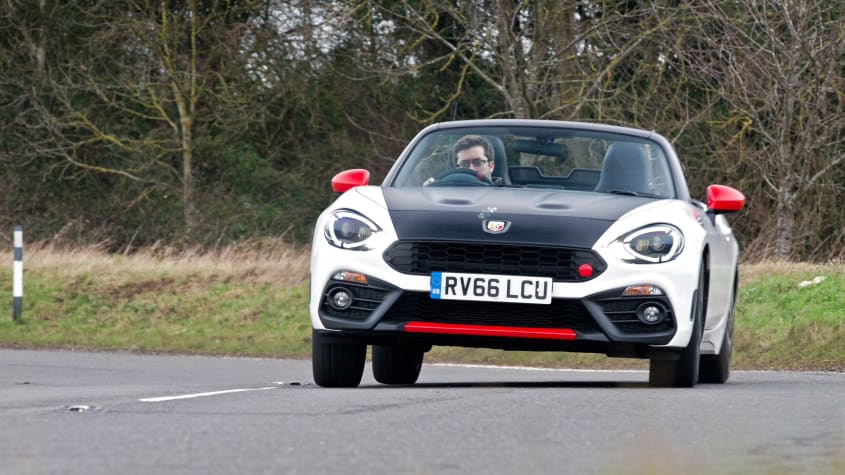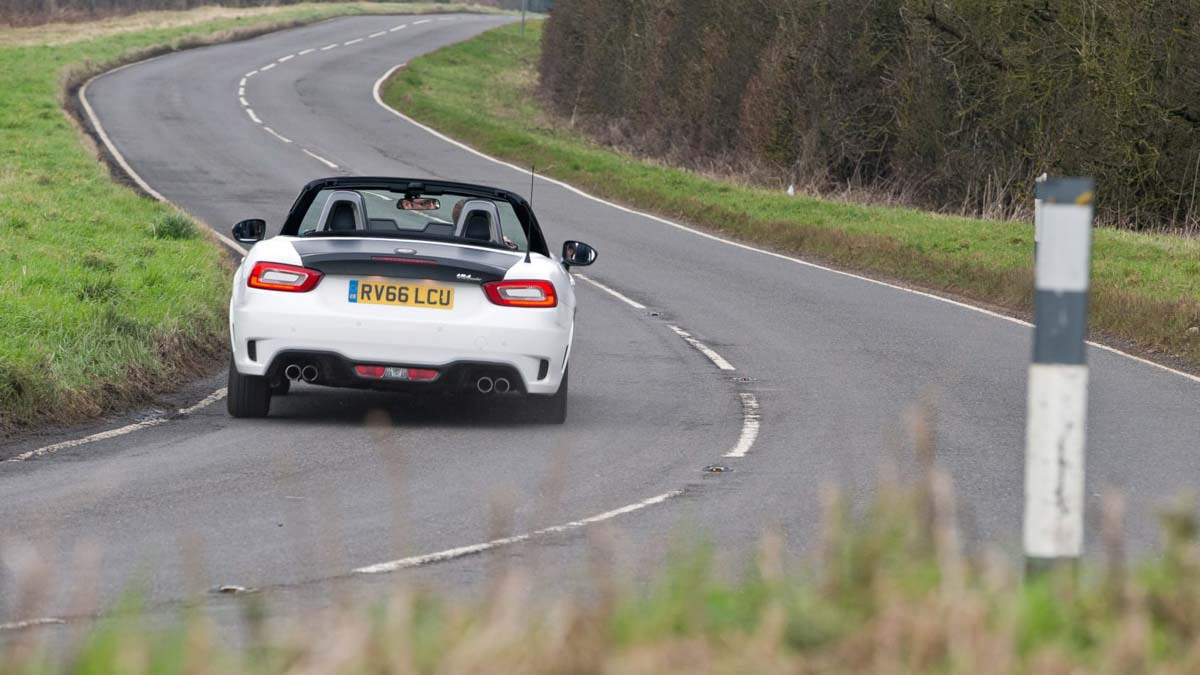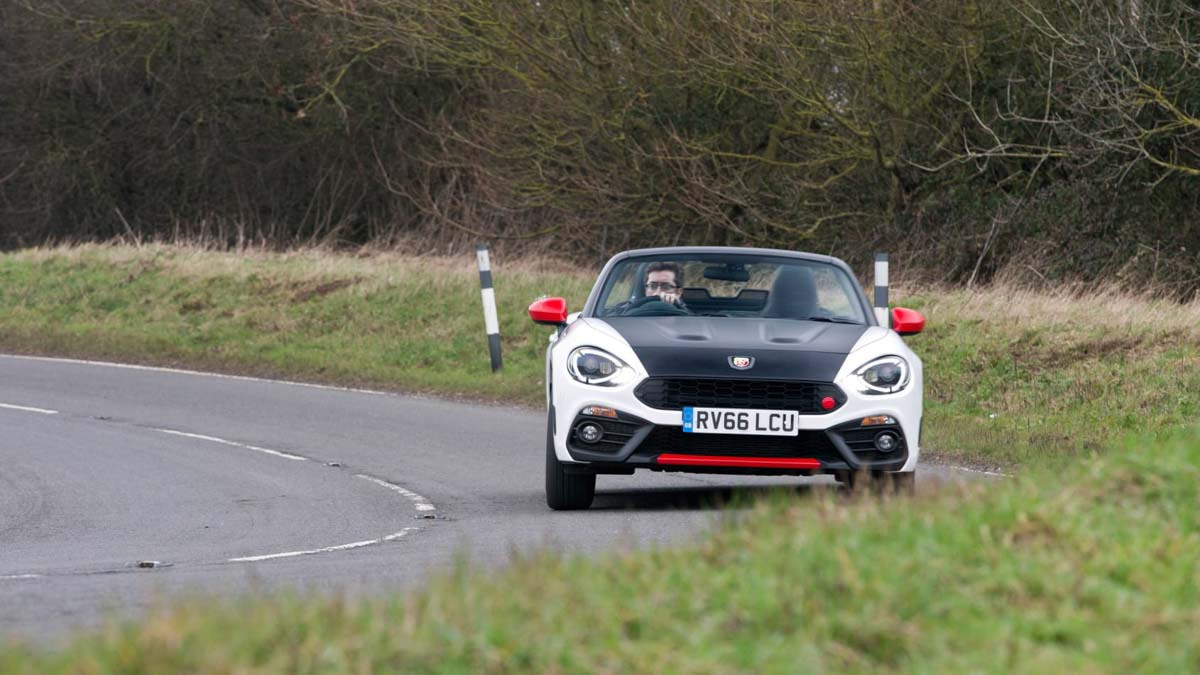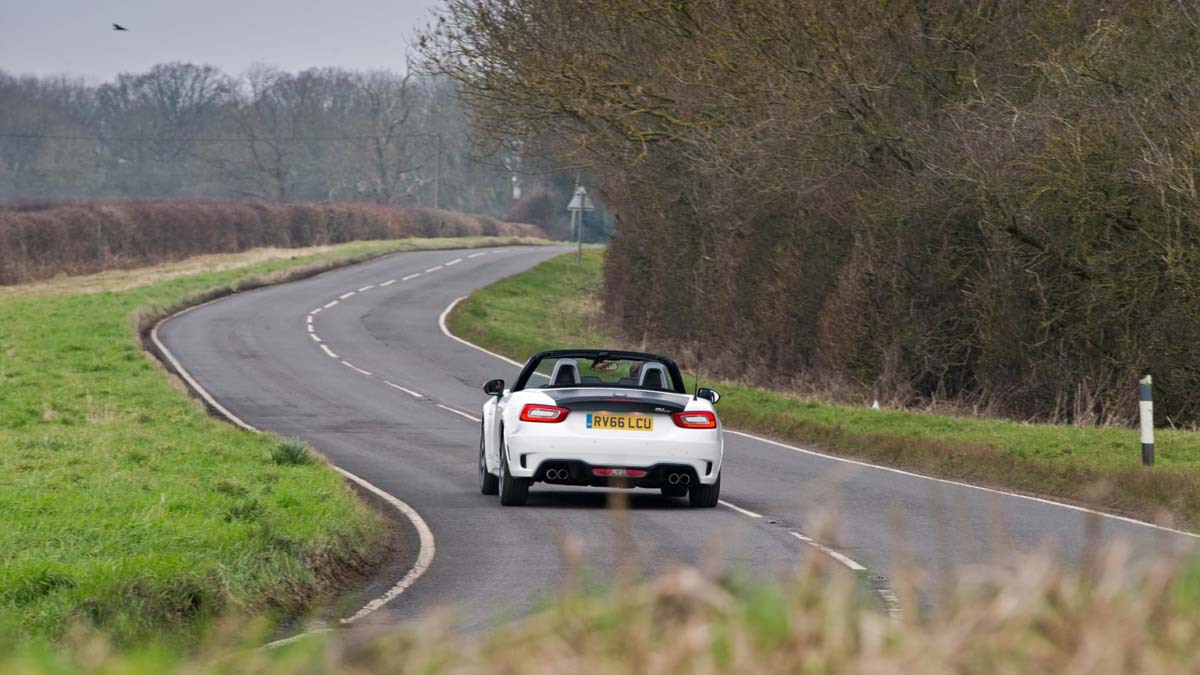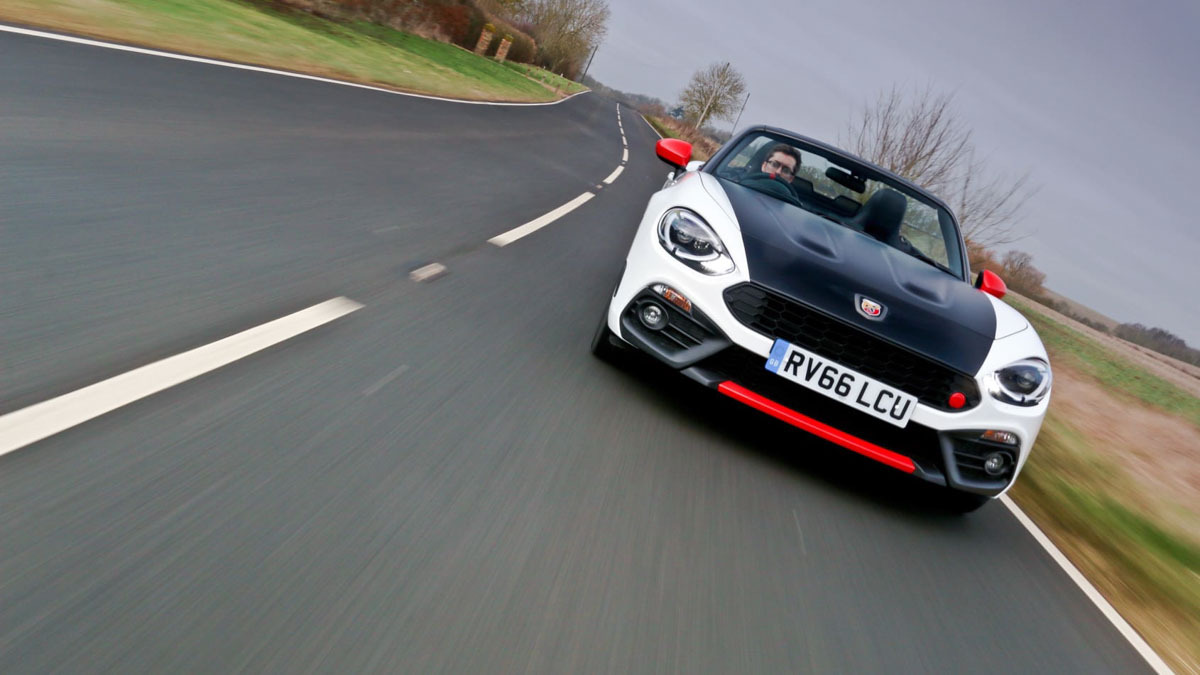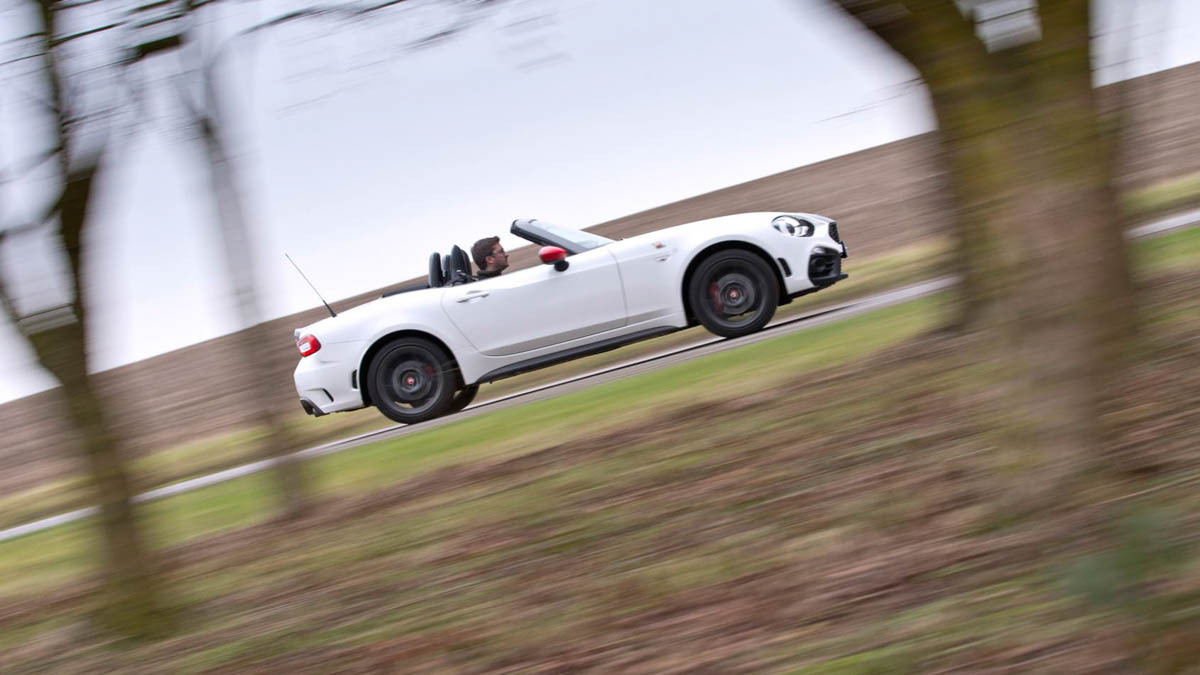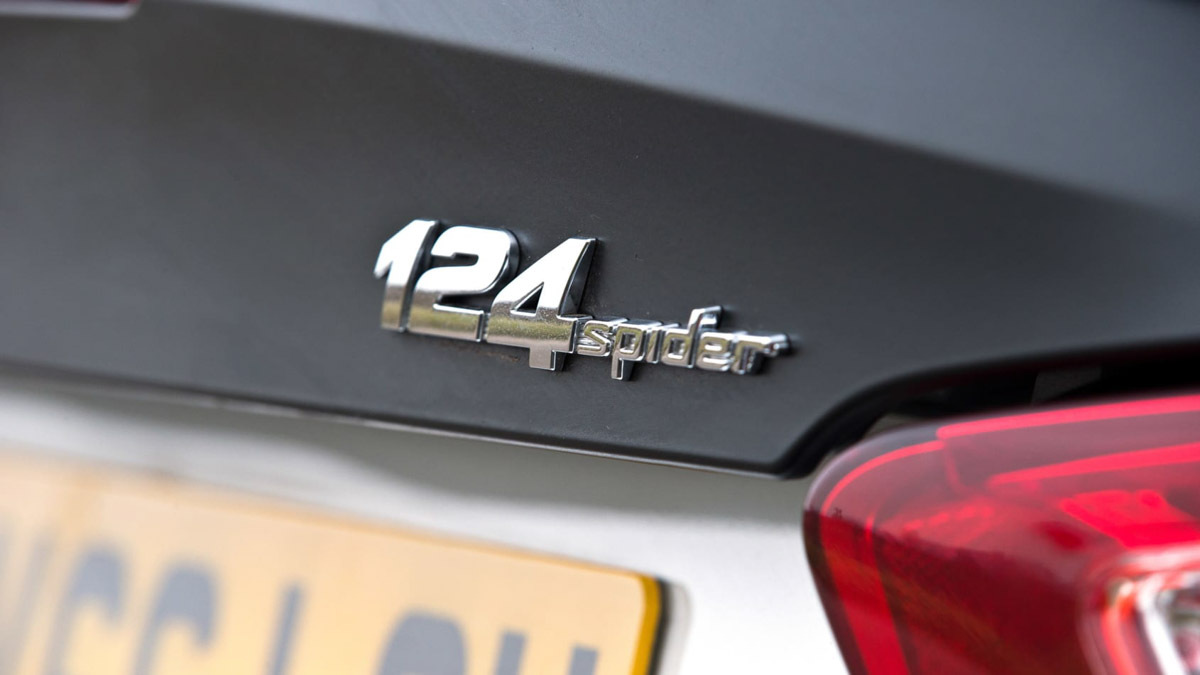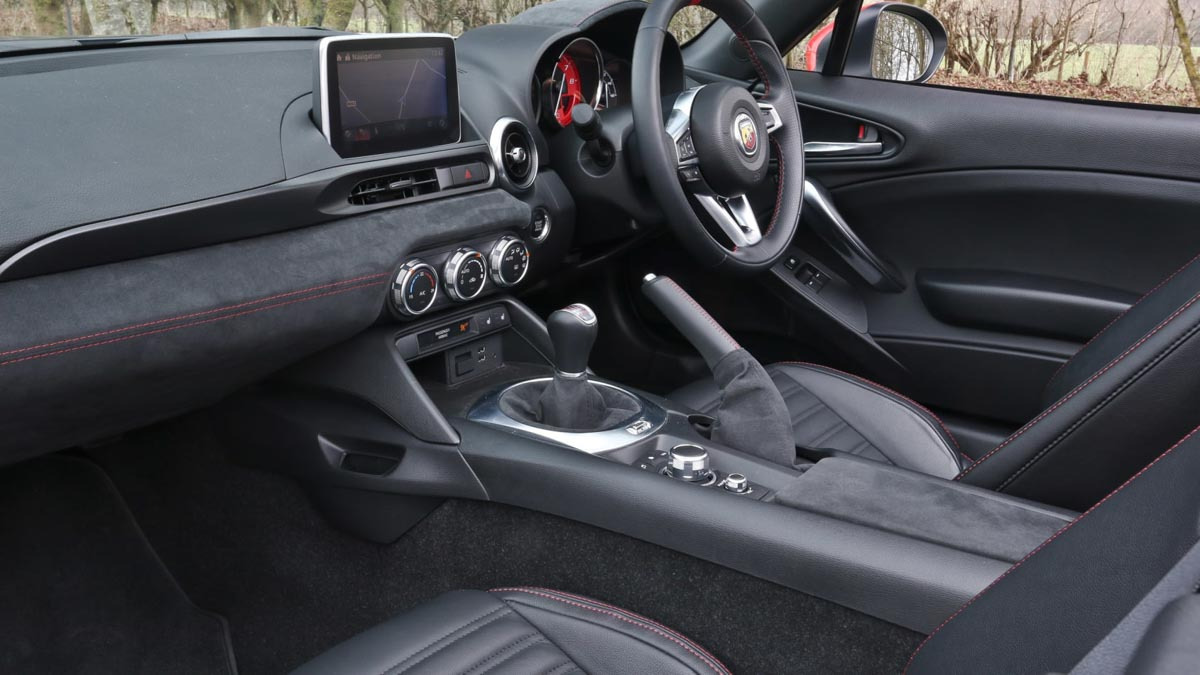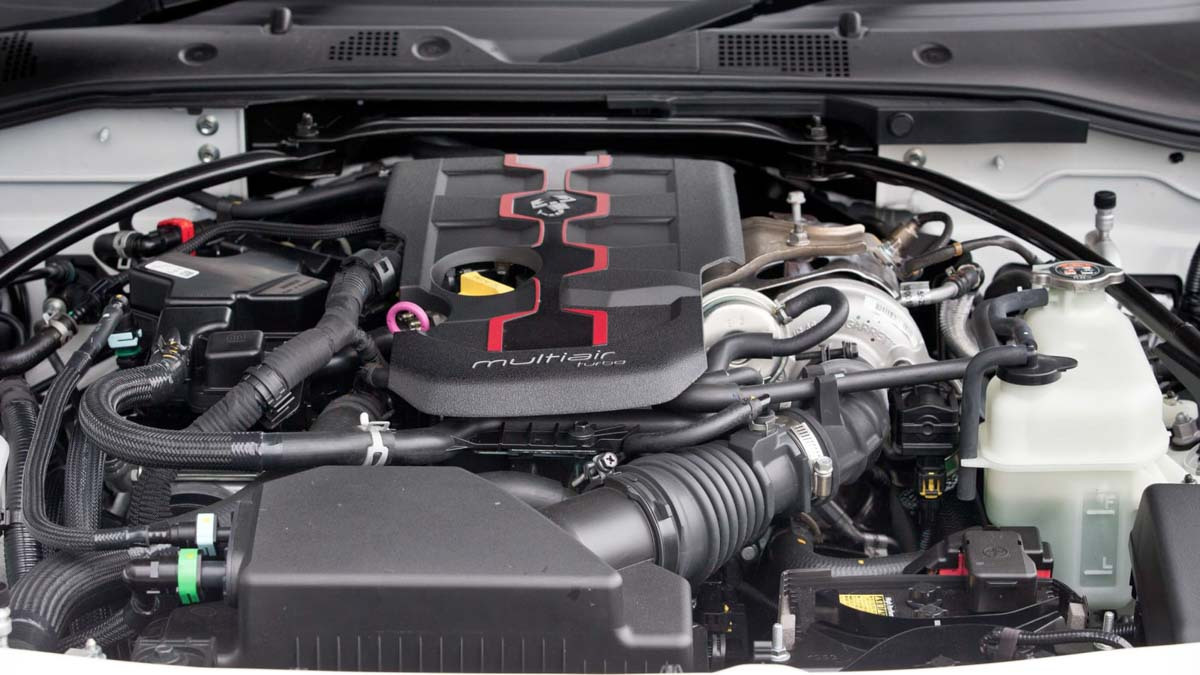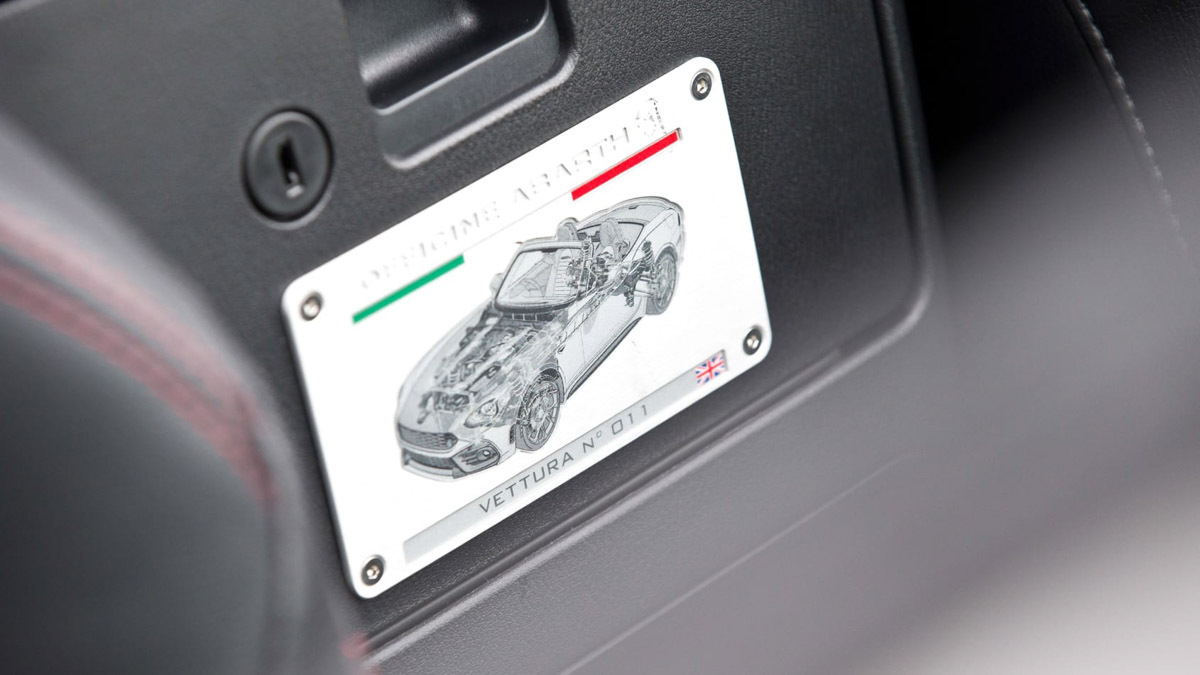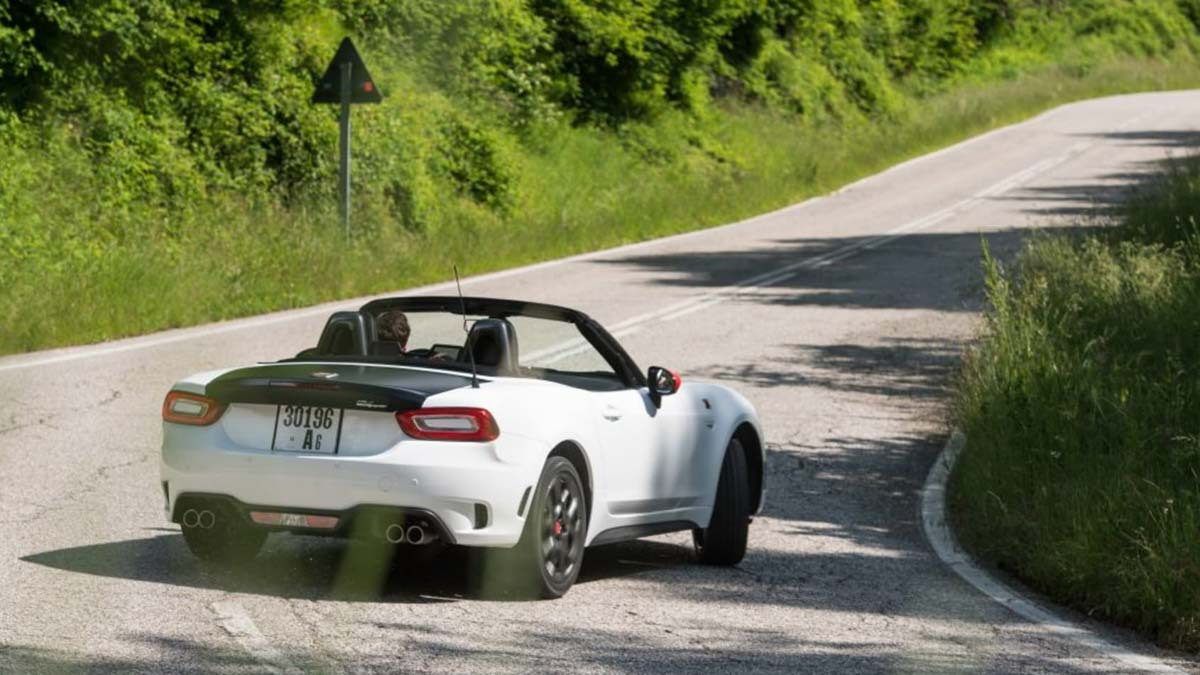Flawed but boisterous; fun and with plenty of character, its problem is a lack of finesse and its dreary engine
The Abarth 124 is a small rear-wheel drive Italian roaster in the traditional sense. Its front-engined rear-wheel drive layout, compact two seater cabin and retro-pastiche styling are derived from a recipe well-used, but the 124’s gestation was a somewhat more convoluted affair than you might expect.
Built in Hiroshima, the small rear-wheel drive chassis comes courtesy of Mazda, while the engine is one of Fiat’s boosty Multiair turbocharged petrol units, rather than the naturally-aspirated twin-cam you’d generally associate with an Italian roadster.
It has also been styled to emulate examples from its past, and while its ingredients might be confused, the supermini supercar demeanor is pure Abarth – all pomp and circumstance, only smaller.
The problem is, it didn’t seem to resonate with buyers, and less than four years on the Abarth 124 Spider has been discontinued, along with its lesser Fiat cousin. As an experiment from a business perspective you might not be surprised by its relative lack of commercial success, but what about its success as a driver’s car.
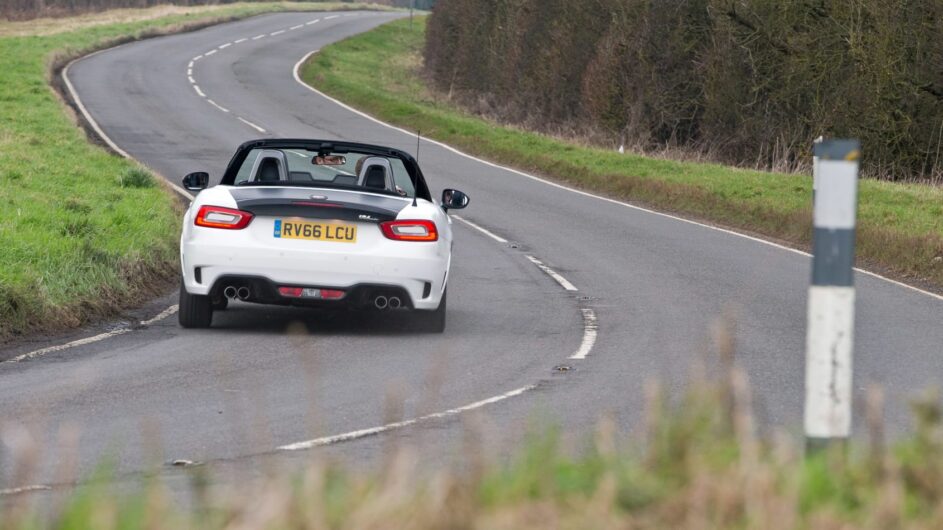
Prices, specs and rivals
At a tad under $37k, the Abarth’s price certainly wasn’t as junior as it’s dimensions would have led you to believe. All models were reasonably well equipped, mind, with the usual spread of convenience features, including Mazda’s infotainment system which is frill-free but easy to use and responsive enough.
The Mazda MX-5 on which it was based is slightly less expensive, and available in more variants spread between $28,850 and $37,023, but you’ll have to shell out at least $35k to get into the 2-litre, which not only nearly matches the Abarth for power, but is also now a sweet, crisp unit befitting the rear-wheel drive chassis.
The Toyota GT86 is also an option at this price point. It’s chassis is inarguably the sweetest in the class, with excellent body control and steering matched with a boisterous handling balance that makes use of excellent balance and its low centre of gravity. The Toyota’s limitations lie in its powertrain, which despite its near-200bhp power figure is tinny, bereft of torque and often feels strained. The transmission too lacks the MX-5 and Abarth’s short shift action and oily-slickness. At just under $35,000 it’s also good value, but it is only available as a coupe.
evo Verdict
Italian and Japanese automotive partnerships haven’t always been the most successful. Giugiaro’s original Lexus GS300 was disappointingly bland, Nissan Autech’s Zagato Stelvio completely bizarre, and the Nissan Cherry-based Alfa Romeo Arna catastrophically awful.
But Mazda and Fiat’s collaboration on the 124 Spider (based on the MX-5, built in Hiroshima and graced with an Italian heart and clothing) is much more like it, and the Abarth 124 Spider is the best of the bunch.
Basically, it’s a lot of fun, and while it has many of the MX-5’s foibles, it also has plenty of character to make up for it. It isn’t the fastest sports car, nor the most sophisticated, but the combination of a roaring turbocharged engine, tactile gearshift and easily-accessible limits make almost any journey enjoyable.
evo Tip
Abarth offers an automatic gearbox in the 124 Spider. We’ve not yet driven an example so-equipped, but it’s hard to imagine the six-speed auto suiting the character of the car quite as well as the snappy, satisfying manual, so we’d be tempted to opt for the latter.
The 124’s distinctive styling is immeasurably improved by the inclusion of the retro-style matt black bonnet and bootlid too, so given it’s an option that comes entirely free of charge, it’s a box we’d tick.
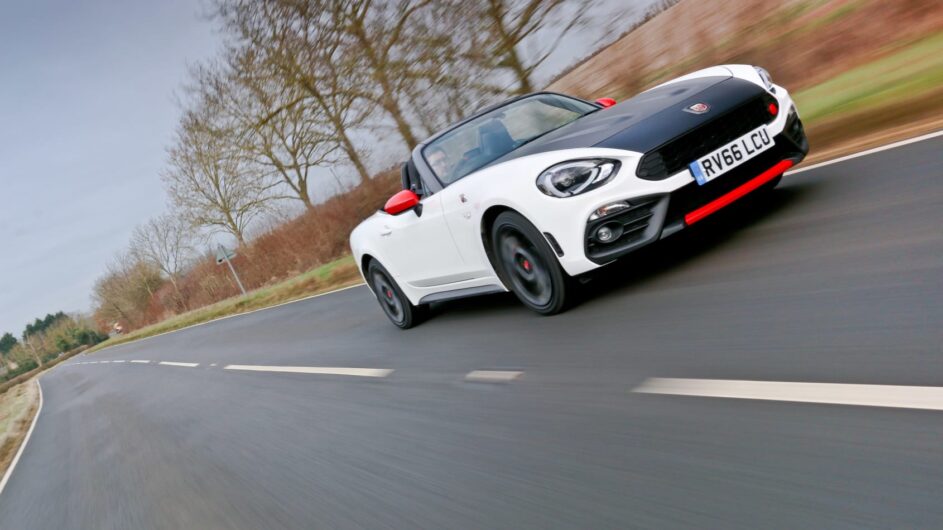
evo Comment
‘With the tration control fully off, the Abarth feels like it can breathe and fully express itself, and without huge reserves of power it’s never intimidating. The limited-slip differential is well tuned to the rest of the car, the speed and degree at which it locks up really helping the Abarth feel instinctive and transparent. With the back end squatting as you work the rear wheels with the throttle, the Abarth can be extremely good fun.’ Will Beaumont
Engine, gearbox and technical highlights
There’s only one Abarth 124 as yet, utilising Fiat’s familiar 1.4-litre turbocharged MultiAir powerplant. Displacing 1368cc across four cylinders and boosted by a small turbocharger mounted amusingly prominently in the engine bay, it develops 170PS at 5500rpm, with 250Nm of torque on tap from 2500rpm.
These outputs are then sent through either a standard six-speed manual transmission or optional six-speed “sequenziale sportivo” automatic to the rear axle, where twist is dealt to each wheel through a standard limited-slip differential.
Spent gases make their own journey to the rear of the car and exit through an amusingly farty “record Monza” exhaust system, which is standard. The exhaust note dominates much of the Abarth 124 experience, emitting a bassy grumble at idle, and a more aggressive parp as the revs rise. It sounds much like the smaller Abarth 500 as you’d expect, but like the hatchback the tone becomes less tuneful at higher revs, at least from inside the car.
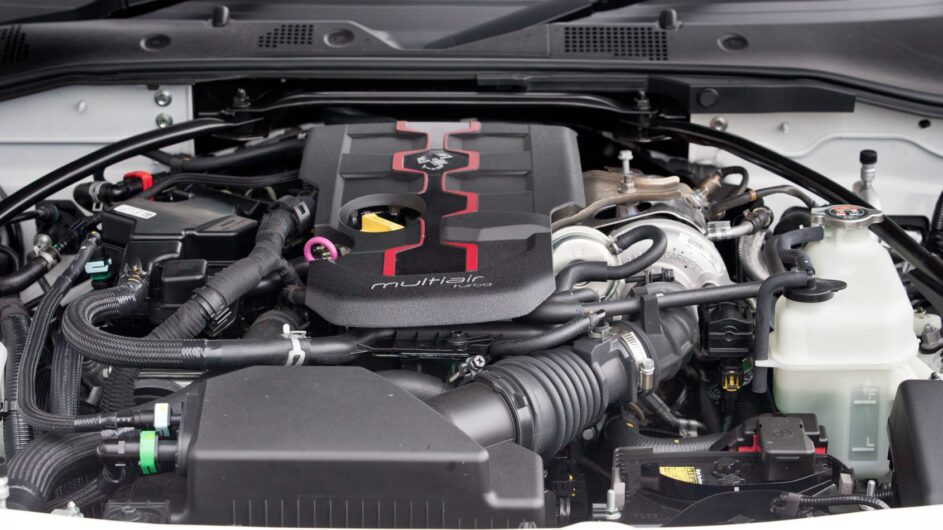
Keep the engine in its sweet spot – somewhere between around 2000-5000rpm – and it’s a satisfying drivetrain to use. The gearshift, as you’d expect given its Mazda MX-5 origins, is fantastic. Possibly better than the MX-5 itself in fact, with a slightly meatier action (possibly a result of the shorter, stumpier lever) and without the slightly twee vibrations through the lever at idle. The engine is responsive too, again providing you keep it spinning in its sweet spot, and it’s free-revving enough to make short blips of the throttle a satisfying experience.Advertisement
It’s better still in Sport mode, which doesn’t add any enthusiasm to the top end but does sharpen low-end response. Combined with pedals well-placed for heel-and-toe it’s great fun stirring up and down the ‘box and working through the rev range.
Performance and 0-100kph time
With a useful boost in power over the standard Fiat 124 Spider comes a modest increase in pace. The Fiat’s 0-100kph time drops from 7.5sec to 6.8sec for the Abarth 124, while top speed grows by 16kph to 232kph. Incidentally, automatic models are barely slower than the manuals, being just a tenth slower to reach 100kph and only 3kph down at the top end.
While the Abarth is only a little more powerful than its 2-litre Mazda MX-5 counterpart in horsepower terms, it does still knock half a tenth from its 0-100kph time and bests it by 20kph when flat out – no doubt a result of developing 25 per cent more torque and doing so 2000rpm lower down the rev range.
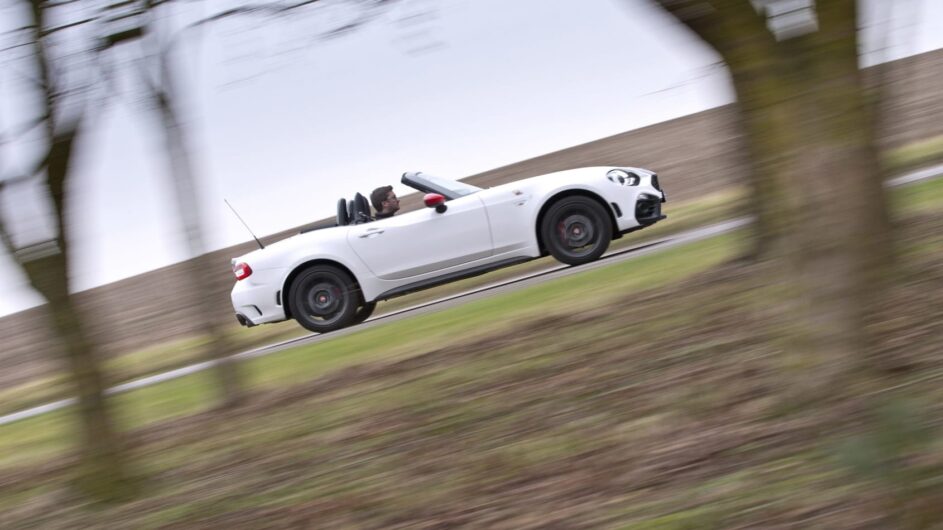
The way the Abarth delivers that performance isn’t quite perfect, however. As you’d expect from a turbocharged engine there’s a definite sweet spot where the 1.4 delivers its best work, but that sweet spot feels all too brief. Little happens below 2000rpm – the non-turbo Mazda feels more responsive here – and there’s little incentive to use the full 6500rpm sweep to the red line when working the engine hard, as it begins to feel flat beyond around 5000rpm.
In contrast, the Mazda’s larger, naturally-aspirated engine isn’t as strong through the mid-range, but doesn’t protest at lower revs and feels (and sounds) sweeter all the way up to its cut-off. Drive on its mid-range torque though the Abarth feels usefully punchy, if not truly fast, and as you’ll see from our ride and handling comments, its performance can be more readily accessed as a tool to play with the car’s balance.
Ride and handling
We noticed it on first acquaintance abroad, and noticed it again having now driven the car in the UK: the Abarth 124 definitely seems to have a stiffer structure than the Mazda MX-5 on which it’s based. Not so stiff that cabin shimmy has been eliminated – you’ll still feel wobbles over harsh surfaces – but it’s a welcome improvement nevertheless.
As is the slight reduction in roll, though again this hasn’t been entirely curtailed, and the 124 still adopts some amusing body angles in corners. Well, slightly frustrating angles actually, as the roll results in a slightly vague response to inputs. Given the steering delivers little information from the road to your fingertips it means there’s always some guesswork involved when turning into corners, particularly if the surface is slippery.
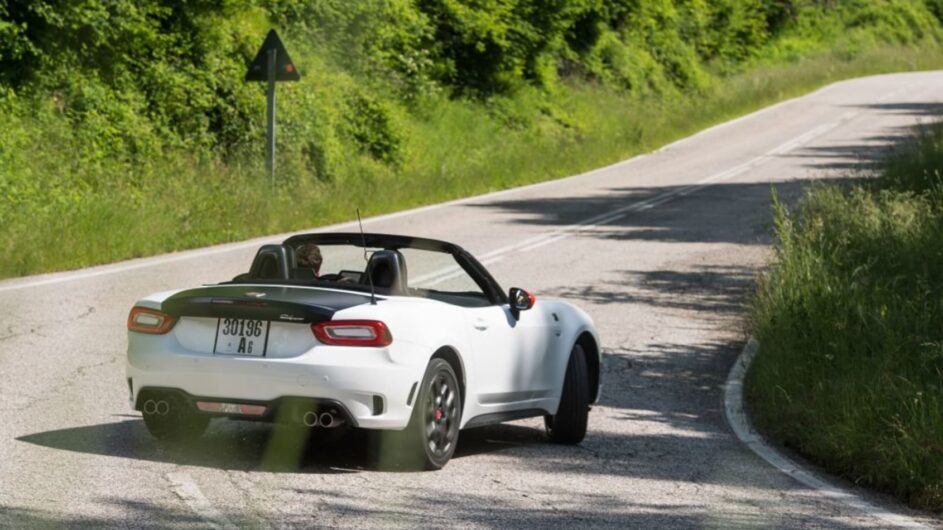
That’s not to say the handling isn’t still a lot of fun. Get your turn-in right and the extra torque of the turbocharged engine gives you more throttle adjustability, more of the time than that of the MX-5. Turn off the traction control, which does allow a degree of slip, and you’ll still need plenty of throttle to break traction, but the lack of chassis feedback means you notice the onset of oversteer through visual cues rather than through your hands. Thankfully the steering is quick and light, so dialling in corrective lock is easy.
Sport mode doesn’t significantly alter the feel of the car, but the quicker throttle response at lower throttle openings, and the slightly weightier steering are different enough to warrant them being your default setting on a spirited drive.
L/100km and running costs
Owning a 124 Spider shouldn’t, in theory, be too financially ruinous. Official combined economy is 6.4L/100km, rising to 6.6L/100km with the automatic transmission. The former figure is identical to that of the regular Fiat 124 Spider, so you lose nothing in frugality for your performance gains, and it’s a fraction better than the 6.9L/100km claimed of the 2-litre MX-5.
Turbo engines can be rather thirsty in the real world however, even small capacity ones, so a figure beginning with a three may be more likely unless you ignore the goading character of the Abarth’s noisy exhaust.
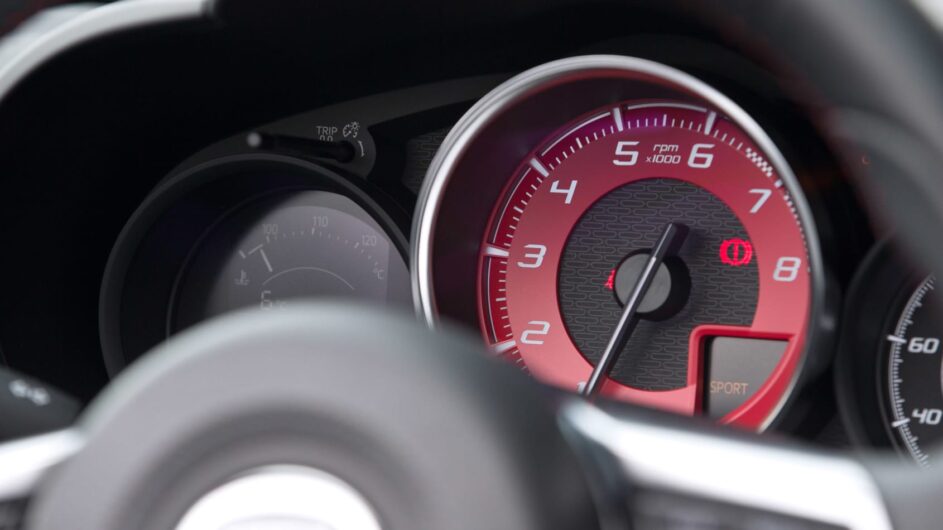
The decent on-paper economy does keep CO2 to a minimum, at 148g/km, so from April 2017 onwards you’ll pay a first-year rate of $250 and a standard rate of $175 a year thereafter. That first year rate is more than the $180 you’d have paid before, but after that it’s actually $7 a year less than it would have been previously.
In our experience with the similarly flyweight MX-5, you shouldn’t chew through consumables too quickly either, provided you don’t spend half your life on track. Rear tyres might get a workout, but the brakes should last a while. Service intervals are a little more strict than that of the Mazda’s 12-month, unspecified mileage – the Abarth requires servicing every 15,000 kilometres or 12 months, whichever comes soonest.
Interior and tech
While Abarth has spent its money altering the MX-5’s styling and gracing the engine bay with a new power unit, it’s made only a token effort giving a latin feel to the Japanese car’s cabin.
That’s not automatically a bad thing, as the MX-5’s interior is generally well-designed. There is a shortage of cubby holes – in place of a glovebox you get a lockable bin between the seat backs, there are no door pockets and the centre console cubby is a bit pokey – but it has a sporty feel and uses materials of decent quality.
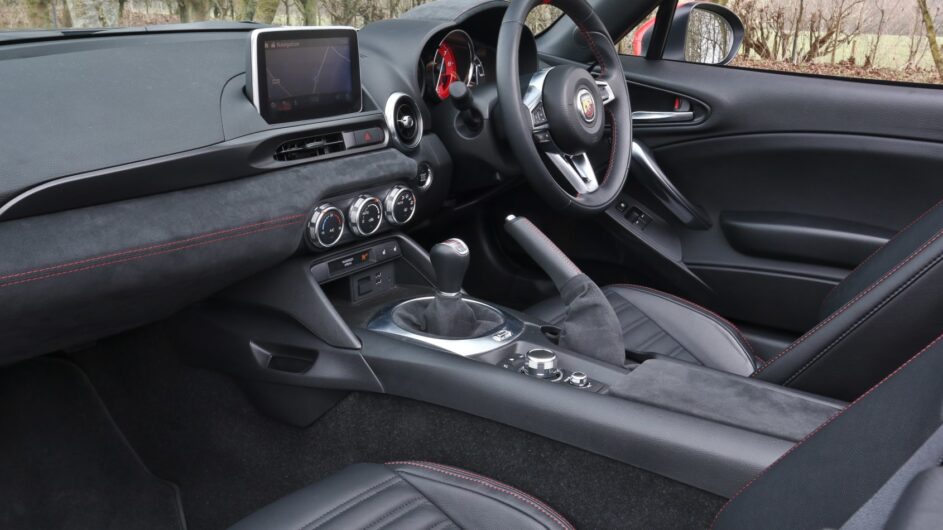
From this base, Abarth changes are largely cosmetic. Door panels are no longer body-coloured, dashboard panels have a smattering of Alcantara trim (as does the scorpion-badged centre cubby/arm rest), and the standard Mazda three-spoke steering wheel gets detail changes, with a slightly thicker rim and the obligatory Abarth shield. Instruments are different too, the central rev counter highlighted in red. The gearlever is also a little shorter than the one found in the Mazda.
It’s hard to shake the feeling you’re not really in an Abarth product though. For all its failings, the Fiat 500-based Abarths feel genuinely unique inside, from their comically oversized metal pedals to their large bewinged bucket seats and cool-to-the-touch aluminium gearshift lever. The Abarth 124 feels very much like a Mazda with a few stylised scorpions dotted about.
Design
Office consensus suggests Fiat hasn’t got the shape of its 124 quite right. Rather than looking classical and Italian, it looks a little wide, slabby and American, with uncomfortably long overhangs both front and rear and a tail section that’s rather bland.
The tail is the Abarth 124’s least successful aspect too (not least because it houses an excessive quartet of exhaust pipes), but elsewhere we think it’s a big improvement on the Fiat. The car’s proportions look better with larger, more arch-filling wheels and tyres, the matt black bonnet and boot lid are a neat nod to the rally-prepared Fiat 124 Abarths of yore, and a smattering of bright red details – door mirrors, front splitter, towing eye cover – draw the attention away from the less successful aspects of the design.
Its best angle? Directly head-on, where it’s both unique and aggressive. But overall, we’re less convinced by the Abarth’s shape than the shorter, curvier MX-5 on which it’s based.
This article originally appeared at evo.co.uk
Copyright © evo UK, Dennis Publishing

